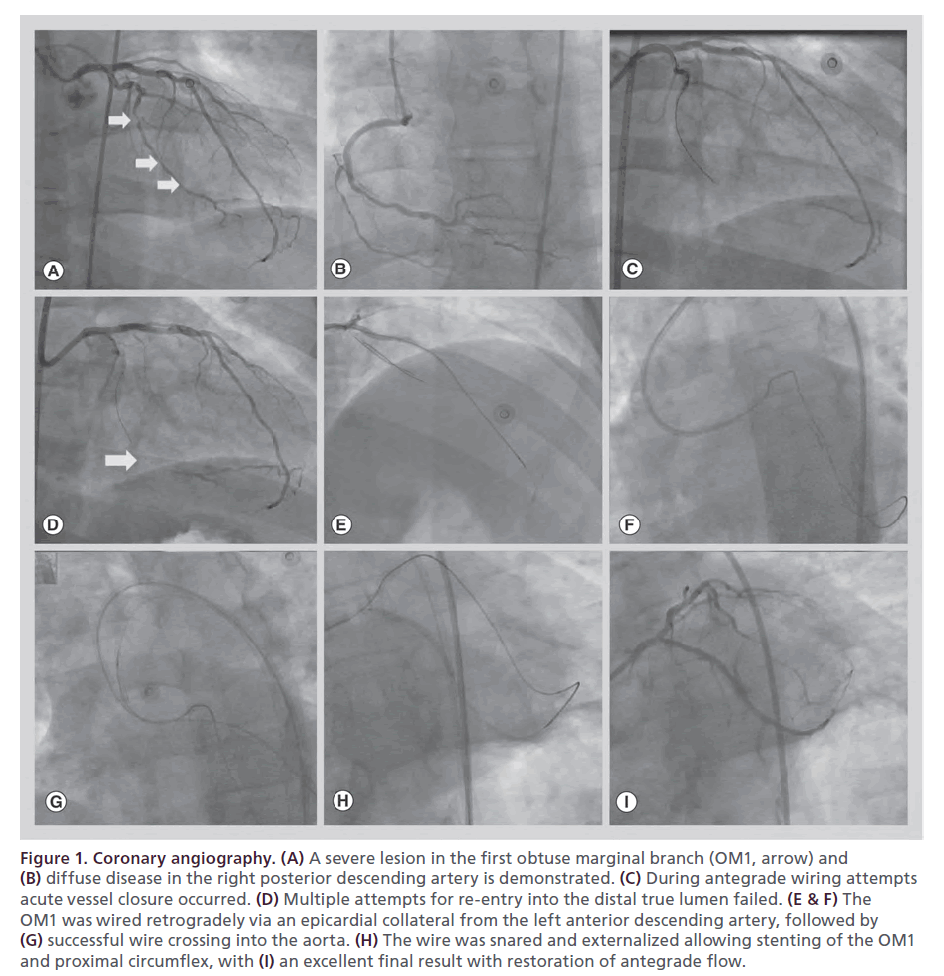Case Report - Interventional Cardiology (2014) Volume 6, Issue 2
Acute vessel closure salvaged by use of the retrograde approach
- Corresponding Author:
- Emmanouil S
Brilakis
VA North Texas Healthcare System and University of Texas Southwestern Medical Center,
4500 South Lancaster Road, Dallas, TX 75216, USA
Tel: +1 214 857 1547
Fax: +1 214 302 1341
E-mail: esbrilakis@gmail.com
Abstract
A 50-year-old man presented with unstable angina. Coronary angiography revealed a severe lesion in the first obtuse marginal branch and the right posterior descending artery. A 0.014’’ Whisper and a Pilot 200 wire (Abbott Vascular, CA, USA) could not cross the lesion and caused acute vessel closure causing severe chest pain and ST-segment elevationKeywords
complications, percutaneous coronary intervention, retrograde approach
Case report
A 50-year-old man presented with unstable angina. Coronary angiography revealed a severe lesion in the first obtuse marginal branch (OM1, culprit lesion; Figure 1A) and the right posterior descending artery (Figure 1B). A 0.014’’ Whisper and a Pilot 200 wire (Abbott Vascular, CA, USA) could not cross the lesion and caused acute vessel closure causing severe chest pain and ST-segment elevation (Figure 1C). Attempts to re-enter into the distal true lumen with a StingRay balloon (Boston Scientific, MA, USA) failed (Figure 1D). A Sion wire (Asahi Intecc, Nagoya, Japan) was advanced through a Corsair microcatheter (Asahi, Intecc, Japan) from the distal left anterior descending artery into the OM1 through an epicardial collateral and then subintimally into the proximal circumflex (Figure 1E). Using the reverse controlled antegrade and retrograde tracking and dissection (reverse CART) technique, a Pilot 200 wire was advanced into the aorta (Figure 1F) and a R350 guidewire (Vascular solutions, MN, USA; Figure 1G) was externalized through a second 8-French EBU3 guide catheter. The proximal circumflex and OM1 branch were stented with three drug-eluting stents (Figure 1H), restoring antegrade flow (Figure 1I).
Figure 1. Coronary angiography. (A) A severe lesion in the first obtuse marginal branch (OM1, arrow) and (B) diffuse disease in the right posterior descending artery is demonstrated. (C) During antegrade wiring attempts acute vessel closure occurred. (D) Multiple attempts for re-entry into the distal true lumen failed. (E & F) The OM1 was wired retrogradely via an epicardial collateral from the left anterior descending artery, followed by (G) successful wire crossing into the aorta. (H) The wire was snared and externalized allowing stenting of the OM1 and proximal circumflex, with (I) an excellent final result with restoration of antegrade flow.
Discussion
Acute closure is a potentially catastrophic percutaneous coronary intervention complication that can lead to acute myocardial infarction, emergency bypass surgery and death [1]. We recently reported the use of limited antegrade subintimal dissection/reentry techniques to restore antegrade flow in a patient with abrupt coronary occlusion [2]. Use of extensive antegrade dissection/ re-entry techniques, such as the subintimal tracking and reentry (STAR) technique [3], is another bailout option, but is ideally avoided because it carries high rates for restenosis and reocclusion, in part due to limited outflow and long stent lengths [4,5]. In the present report we demonstrate use of the retrograde approach [6] through an ipsilateral collateral for treating acute vessel closure. This strategy can only be used in sub-occlusive lesions where collaterals have developed allowing retrograde access to the distal vessel and is likely not feasible in less severe lesions with poorly developed collateral circulation.
Although the retrograde approach was successful in our patient, it should only be used as a last-resort approach by highly experience operators in this technique, since it carries significant risks (such as collateral vessel perforation) and can be time consuming to implement [7].
Financial & competing interests disclosure
S Banerjee has received research grants from Gilead and The Medicines Company. He has also acted as a consultant and has received speakers’ honoraria from Covidien and Medtronic, and also has ownership in MDCARE Global (spouse) and intellectual property in HygeiaTel. ES Brilakis has received consulting honoraria and speakers’ fees from Sanofi, Janssen, St. Jude Medical, Terumo, Asahi, Abbott Vascular and Boston Scientific, as well as a research grant from Guerbet; his spouse is an employee of Medtronic. The authors have no other relevant affiliations or financial involvement with any organization or entity with a financial interest in or financial conflict with the subject matter or materials discussed in the manuscript apart from those disclosed.
No writing assistance was utilized in the production of this manuscript.
Executive summary
• Acute vessel closure can be a catastrophic percutaneous coronary intervention complication.
• Use of the retrograde approach can allow vessel recanalization in patients with acute vessel closure after all other attempts fail.
• Use of the retrograde approach for acute vessel closure is a last-resort method to be used only by experienced chronic total occlusion operators.
References
- Almeda FQ, Nathan S, Calvin JE, Parrillo JE, Klein LW. Frequency of abrupt vessel closure and side branch occlusion after percutaneous coronary intervention in a 6.5-year period (1994 to 2000) at a single medical center. Am. J Cardiol. 89(10), 1151–1155 (2002).
- Martinez-Rumayor AA, Banerjee S, Brilakis ES. Knuckle wire and stingray balloon for recrossing a coronary dissection after loss of guidewire position. JACC Cardiovasc. Interv. 5(10), e31–e32 (2012).
- Colombo A, Mikhail GW, Michev I et al. Treating chronic total occlusions using subintimal tracking and reentry: the STAR technique. Catheter Cardiovasc. Interv. 64(4), 407–411; discussion 412 (2005).
- Michael TT, Papayannis AC, Banerjee S, Brilakis ES. Subintimal dissection/reentry strategies in coronary chronic total occlusion interventions. Circ. Cardiovasc. Interv. 5(5), 729–738 (2012).
- Valenti R, Vergara R, Migliorini A et al. Predictors of reocclusion after successful drug-eluting stent-supported percutaneous coronary intervention of chronic total occlusion. J. Am. Coll. Cardiol. 61(5), 545–550 (2013).
- Brilakis ES, Grantham JA, Thompson CA et al. The retrograde approach to coronary artery chronic total occlusions: a practical approach. Catheter Cardiovasc. Interv. 79(1), 3–19 (2012).
- Brilakis E. Manual of Coronary Chronic Total Occlusion Interventions. A Step-By-Step Approach. Elsevier, MA, USA (2013).


